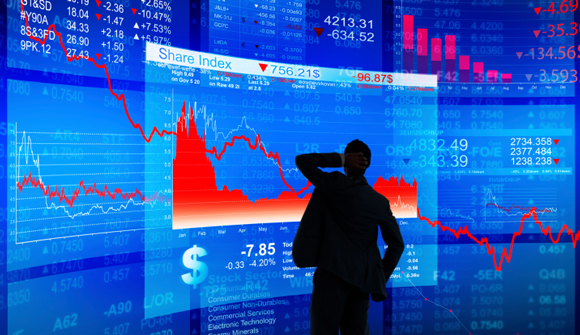
October 28, 1929– 90 years ago today– is known as ‘Black Monday’ in financial circles.
The US stock market had peaked the previous month, on September 3, 1929, with the Dow Jones stock index reaching a record high of 381.
But throughout September and October, nervous investors began pulling their money out of the market.
And over a three day period in late October (including Black Monday), the market lost more than 30% of its value.
Ninety years later, I thought it would be prudent to look at three key insights from that historic crash, starting with:
1) Stocks are more overvalued today than they were in 1929
Back in 1929, the price/earnings ratio of the average company trading on the New York Stock Exchange was about 15.
In other words, investors were willing to pay $15 per share for every $1 of the average company’s profit.
That’s not high at all. In fact, a Price/Earnings ratio of 15 is completely in line with historic averages.
Coca Cola’s Price/Earnings ratio back in 1929 ranged between 15 and 18. Today it’s 30… meaning that investors today are willing to pay roughly twice as much for each dollar of Coke’s annual profit.
Coca Cola is actually quite an interesting case study.
If we just go back a few years to 2010, Coca Cola’s annual revenue was $35 billion. By 2018 the company’s annual revenue had fallen to less than $32 billion.
In 2010, Coca Cola generated $5.06 in profit (earnings) per share. In 2018, just $1.50.
And Coca Cola’s total equity, i.e. the ‘net worth’ of the business, was $31 billion in 2010. By 2018, equity had fallen to $19 billion.
So over the past eight years, Coca Cola has lost nearly 40% of its equity, sales are down, and per-share earnings have fallen by 70%.
Clearly the company is in far worse shape today than it was eight years ago.
Yet Coke’s share price has nearly DOUBLED in that period.
Crazy, right?
It’s not just Coca Cola either; the Price/Earnings ratio of the typical company today is about 50% higher than historic averages.
(This means that the stock market would have to drop by 50% for these ratios to return to historic norms.)
It’s clear that investors are simply willing to pay much more for every dollar of a company’s earnings and assets than just about ever before, including even right before the crash of 1929.
2) Stocks fell by nearly 90% in 1929… and it took decades to recover.
The ‘crash’ wasn’t isolated to Black Monday.
From the peak in September 1929, stocks ultimately fell nearly 90% over the next three years. The Dow bottomed out in 1932 at just 42 points.
42 is lower than where the Dow was trading in 1885… so the crash wiped out DECADES of growth. And it took until November 1954 for the Dow to finally surpass its high from 1929.
If that were to happen today, it means the Dow would fall to just 2,700… a level it hasn’t seen since the early 1990s. And it wouldn’t return to today’s highs until the mid 2040s.
Most people think this is completely preposterous.
And to be fair, I think the government and central bank will do everything in their power to prevent a severe crash.
The Federal Reserve has already announced that it will print another $60+ billion per month, which should be favorable for the stock market in the short term.
But just because we can’t imagine something happening doesn’t mean it can’t happen. In fact it’s happening right now in Japan:
Japan’s stock market peaked in late 1989 with its Nikkei index reaching nearly 39,000.
Within a few years the Nikkei had lost half of its value and would ultimately fall by 80%.
Even today, thirty years later, the Nikkei index is still 40% below its all-time high.
There is no law that requires the stock market to go up. It can fall. And it can stay low for years… even decades.
3) Adjusted for inflation, stocks have returned just 1.7% per year since 1929.
It’s best to think long-term about any investment. Businesses take time to grow and expand, and patient investors who understand this tend to do well.
But when thinking about the long-term, it’s imperative to consider the extraordinary effects of inflation.
Every single year your money loses around 2% of its value. But over time those small bites of inflation fester into a major chunk of your investment gains.
Consider that, even according to the federal government’s monkey math, the US dollar has lost 94% of its value since 1929.
So even though the Dow is more than 70x higher than it was in mid-1929, when you consider the effects of inflation, stocks are only about 5x higher over the past 90 years.
That works out to be an average annualized return of just 1.7%.
Even over the past 20 years– if you go back to late 1999, the stock market has only returned about 2.2% per year when adjusted for inflation.
Think about all the risks and wild market swings that investors have had to deal with over the past 20 years– all for a measly 2.2%.
It’s interesting to note that, when adjusted for inflation, GOLD has outperformed stocks over the long run.
When adjusted for inflation, gold has averaged a 1.8% return since 1929 (slightly higher than stocks), and a 6.7% return since 1999– more than 3x as much as stocks.
But unlike stocks, people who own gold haven’t had to put up with the same risks. No shady brokers. No WeWork bullshit. No Enron scandal.
They earned 3x more than the stock market– with the added benefit of being able to hold their investment right in their own hands.
